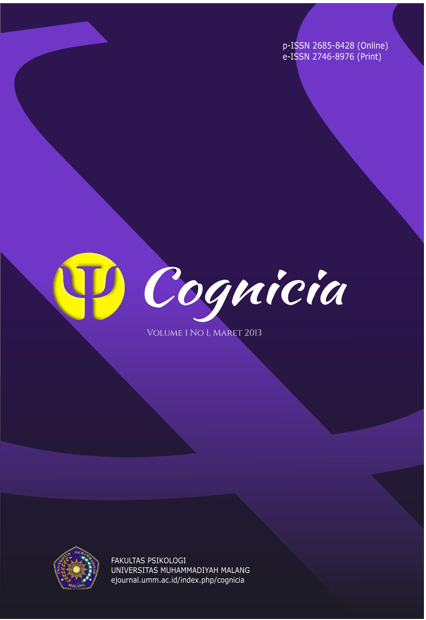PERSEPSI INSENTIF DENGAN KONFLIK KERJA KARYAWAN PERUSAHAAN ROTI SALWA TRENGGALEK
DOI:
https://doi.org/10.22219/cognicia.v1i1.1454Abstract
Di sebuah perusahaan insentif bisa memunculkan berbagai persepsi di antara para karyawan yang dapat memicu terjadinya konflik kerja diantara mereka. Penelitian ini bertujuan untuk mengetahui hubungan antara persepsi insentif dengan konflik kerja karyawan di Perusahan Roti Salwa Trenggalek.Penelitian ini merupakan penelitian kuantitatif non eksperimen. Subyek dari penelitian ini adalah seluruh karyawan bagian pengepakan Perusahaan Roti Salwa Trenggalek sebanyak 40 orang. Metode pengumpulan data menggunakan skala persepsi insentif dan skala konflik kerja yang diberikan kepada responden secara langsung. Uji validitas penelitian ini menggunakan korelasi product moment, dan uji reliabilitasnya menggunakan alpha cronbach. Sedangkan analisa datanya menggunakan product moment. Penelitian menunjukkan bahwa ada hubungan negatif dan sangat signifikan antara persepsi insentif dengan konflik kerja dengan korelasi (r) sebesar -0,509 dan nilai probabilitas kesalahan (p) sebesar 0,001. Hal ini berarti semakin negatif persepsi karyawan tentang insentif yang diberikan oleh Perusahaan Roti Salwa maka semakin kuat konflik kerja mereka. Adapun sumbangan efektif persepsi insentif dengan konflik kerja sebesar 25,9%.
Kata kunci : persepsi insentif, konflik kerja
Incentive system generates various perceptions among the employee that leads to job conflicts among the employees. The study aimed to know the correlation between the employees’ perception on the incentive system and the employees’ job conflicts at Salwa bakery, Trenggalek.The study employed non experimental quantitative design. The research subjects were 40 employees of packaging division at Salwa Bakery, Trenggalek. The data collection was conducted by distributing the scale of incentive perception and job conflicts directly to the respondents. The validity and the reliability were tested by the product moment correlation and alpha cronbach consecutively. Afterwards, the data were analyzed by the product moment.The findings showed a significantly negative correlation between the employees’ perception on the incentive system and the employees’ job conflicts with the correlation (r) = -0,509 and the error probability (p) = 0,001. It indicated that employee’s negative perception on the incentive system significantly correlated with the employees’ job conflicts at Salwa Bakery. In addition, the perception was able to affect the job conflicts with the value of 25,9%.
Keyword: Perception on incentive system, Job conflict
Downloads
Downloads
Published
How to Cite
Issue
Section
License
Copyright (c) 1970 Rahayu Yudha Fitriana

This work is licensed under a Creative Commons Attribution-ShareAlike 4.0 International License.
Authors who publish with Jurnal Cognicia agree to the following terms:
- For all articles published in Jurnal Cognicia, copyright is retained by the authors. Authors give permission to the publisher to announce the work with conditions. When the manuscript is accepted for publication, the authors agree to automatic transfer of the publishing right to the publisher.
- Authors retain copyright and grant the journal right of first publication with the work simultaneously licensed under a Creative Commons Attribution-ShareAlike 4.0 International License that allows others to share the work with an acknowledgment of the work's authorship and initial publication in this journal.
- Authors are able to enter into separate, additional contractual arrangements for the non-exclusive distribution of the journal's published version of the work (e.g., post it to an institutional repository or publish it in a book), with an acknowledgment of its initial publication in this journal.
- Authors are permitted and encouraged to post their work online (e.g., in institutional repositories or on their website) prior to and during the submission process, as it can lead to productive exchanges, as well as earlier and greater citation of published wor (See The Effect of Open Access).

This work is licensed under a Creative Commons Attribution-ShareAlike 4.0 International License







